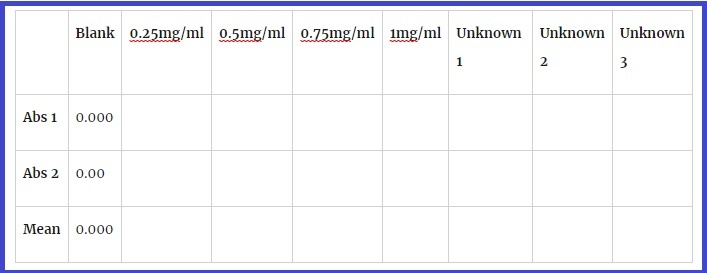Where to find a BMWP and ASPT Calculator
Are you looking for a BMWP AND ASPT Calculator or a template for calculating BMWP and ASPT scores? Or, are you looking for an overall BMWP score calculator, a template for calculating Biological Monitoring Working Party score? Calculating BMWP and ASPT scores can be a challenge especially if you have a lot of data to work with and yet you need to calculate BMWP scores fast. However, with a template for calculating BMWP scores, you can calculate BMWP scores fast and easily. Likewise, with an ASPT score calculator, you can calculate ASPT scores fast and easily. Here is a BMWP score calculator and ASPT score calculator that you can use to calculate overall BMWP score and ASPT score for your sites or samples easily.
Download BMWP and ASPT Calculator
The calculator is a template in excel format that you have to download to use. After downloading the file, fill in the necessary information (such as the names of macroinvertebrate families, their corresponding tolerance or sensitivity scores, and the number of family members observed in a site or sample). Here are a few words that may be used to describe the template:
- ASPT score calculate excel
- ASPT score calculate template
- Average Score Per Taxon score calculator
- BMWP score calculate excel
- BMWP score calculate template
- Template for calculating ASPT score
- Template for calculating Average Score Per Taxon score
- Total BMWP score calculator
Download BMWP AND ASPT Calculator/Template
What are BMWP and ASPT Scores?
At this point, you may be wondering what is BMWP and what is ASPT? The Biological Monitoring Working Party (BMWP) and the Average Score Per Taxon (ASPT) are commonly used methods of assessing the quality of aquatic ecosystems. In simple terms, they are means of measuring the quality of water in a site or sample. Both BMWP and ASPT work on the principle that different aquatic invertebrates have different levels of tolerance or sensitivity to pollutants. The ASPT score for a site or sample is derived from BMWP score as you will see later on. BMWP specifically assumes that different aquatic invertebrates are sensitive to organic pollution to different levels.

Organic pollution often leads to enrichment of the aquatic environment with nutrients, which in turn impacts the level of dissolved oxygen in water. Organisms which are highly sensitive or intolerant to pollution will easily die or migrate from polluted environments. Against this background, the BMWP system assigns scores to each macro invertebrate family/taxon based on how sensitive they are to organic pollution. As an example, the presence of stoneflies and mayflies, which are highly sensitive to pollutants, around a water body indicates that the water body is very clean. It is for this reason that these organism families are often assigned a high sensitivity or tolerance score (say 10.0). Invertebrates such as worms (Oligochaeta) which are less sensitive to pollution (or highly tolerant to pollution) are usually assigned a low score (say 1.0).
The BMWP system assumes that the higher the number of different macroinvertebrate families in a site, the better that quality of water therein. This assumption is based on the notion that water bodies with less pollutants attract even more “sensitive” species, which translates to a higher diversity. Different aquatic invertebrates are suited to different geographical location and ecological conditions. Against this reality, for the BMWP system to provide more accurate results, the BMWP or sensitivity score of each of the macroinvertebrate family/taxon should be calibrated to the specific geographical and ecological conditions where they are found.
How to calculate the BMWP and ASPT score
The (overall) BMWP score for a site or sample is computed by adding the sensitivity or tolerance scores of all the macroinvertebrate families/taxa in the site or sample. This is what the Biological Monitoring Working Party score calculator is designed to do. Generally, a higher (overall) BMWP score reflects better water quality. It is important to note that the BMWP score does not depend on the actual number of individual organisms that are members of a family observed in a location or sample but rather on the presence or absence of the family.
ASPT is calculated by dividing the Biological Monitoring Working Party (BMWP) score by the number of families/taxa represented in the aquatic ecosystem of the location being studied. Generally, a higher ASPT score reflects better water quality. The main difference between BMWP score and ASPT score is that the latter is not dependent on family richness.
ASPT score formula
ASPT score = BMWP score ÷ Number of macroinvertebrate families or taxa.
BMWP Score Calculation Example
In a site along river ABC, the following data was collected in a particular month. Compute the BMWP Score for the site. The sensitivity scores for the different macroinvertebrates usually found in the ABC river ecosystem are also provided in the table below.
|
Taxon/Family |
Number of family members observed |
Sensitivity Score |
|
Ancylidae |
2 |
5.6 |
|
Asellidae |
3 |
2.1 |
|
Baetidae |
12 |
5.3 |
|
Caenidae |
0 |
7.1 |
|
Chironomidae |
9 |
3.7 |
|
Chloroperlidae |
5 |
12.4 |
|
Crangonyctidae |
0 |
6 |
|
Dendrocoelidae |
0 |
5 |
|
Dugesiidae |
0 |
5 |
|
Dytiscidae |
20 |
4.8 |
|
Elmidae |
32 |
6.4 |
|
Ephemerellidae |
0 |
7.7 |
|
Erpobdellidae |
0 |
2.8 |
|
Gammaridae |
80 |
4.5 |
|
Gerridae |
0 |
4.7 |
|
Glossiphoniidae |
2 |
3.1 |
|
Glossosomatidae |
0 |
7 |
|
Goeridae |
0 |
9.9 |
|
Heptageniidae |
15 |
9.8 |
|
Hydrobiidae |
85 |
3 |
|
Hydropsychidae |
3 |
6.7 |
|
Hydroptilidae |
0 |
6.7 |
|
Lepidostomatidae |
5 |
10.4 |
|
Leptoceridae |
20 |
7.8 |
|
Leuctridae |
5 |
9.9 |
|
Rhyacophilidae |
50 |
8.3 |
|
Sericostomatidae |
0 |
9.2 |
|
Simuliidae |
0 |
5.8 |
|
Sphaeriidae |
20 |
3.6 |
|
Taeniopterygidae |
0 |
10.8 |
|
Tipulidae |
2 |
5.5 |
To determine the BMWP score, add the sensitivity scores for all the families that had at least one organism observed. In other words, exclude from the addition any family or taxa that had zero number of families observed (e.g. Caenidae, Crangonyctidae, and Dendrocoelidae). In the table below, the total in the sensitivity score column is the overall BMWP score, total BMWP score, or simply, BMWP score.
|
|
Taxon/Family |
Number of family members observed |
Sensitivity Score |
|
1 |
Ancylidae |
2 |
5.6 |
|
2 |
Asellidae |
3 |
2.1 |
|
3 |
Baetidae |
12 |
5.3 |
|
4 |
Chironomidae |
9 |
3.7 |
|
5 |
Chloroperlidae |
5 |
12.4 |
|
6 |
Dytiscidae |
20 |
4.8 |
|
7 |
Elmidae |
32 |
6.4 |
|
8 |
Gammaridae |
80 |
4.5 |
|
9 |
Glossiphoniidae |
2 |
3.1 |
|
10 |
Heptageniidae |
15 |
9.8 |
|
11 |
Hydrobiidae |
85 |
3 |
|
12 |
Hydropsychidae |
3 |
6.7 |
|
13 |
Lepidostomatidae |
5 |
10.4 |
|
14 |
Leptoceridae |
20 |
7.8 |
|
15 |
Leuctridae |
5 |
9.9 |
|
16 |
Rhyacophilidae |
50 |
8.3 |
|
17 |
Sphaeriidae |
20 |
3.6 |
|
18 |
Tipulidae |
2 |
5.5 |
|
|
BMWP Score |
112.9 |
ASPT Score Example
As previously noted, the formula for finding the ASPT score is: BMWP score/ Number of families represented.
The BMWP Score = 112.9
The number of families which were represented in the data are 18
The ASPT score = 112.9/18 = 6.27
How to interpret BMWP and ASPT scores.
Different studies and locations interpret the BMWP score using different keys. Here we present two commonly used keys.
|
KEY A |
KEY B |
||||
|
BMWP Score |
Category |
BMWP Score |
Category |
Interpretation |
|
|
<15 |
Very Bad |
0-10 |
Very Poor |
Heavily Polluted |
|
|
15-35 |
Bad (Very Contaminated) |
11-40 |
Poor |
Polluted or Impacted |
|
|
36-60 |
Bad (Contaminated) |
41-70 |
Moderate |
Moderately Impacted |
|
|
61-100 |
Moderate |
71-100 |
Good |
Clean but slightly impacted |
|
|
101-120 |
Good |
>100 |
Very Good |
Unpolluted/Unimpacted |
|
|
>120 |
Excellent |
|
|
||
|
|
|
|
|
||
|
ASPT Score |
Category |
ASPT Score |
Category |
|
|
|
0-3.6 |
Bad |
0-3.6 |
Bad |
|
|
|
3.6-4.2 |
Moderate |
3.6-4.2 |
Moderate |
|
|
|
4.3-4.7 |
Good |
4.3-4.7 |
Good |
|
|
|
4.8-5.4 |
Very Good |
4.8-5.4 |
Very Good |
|
|
|
>5.4 |
Excellent |
>5.4 |
Excellent |
|
|
Using Key A, based on the BMWP score, water quality in the site studied is “Good”. Using the same key, based on the ASPT score, water quality at the site is “Excellent”.
This BMWP score calculate template can help you perform such calculations fast and easily. Using the template, you can compute scores for a maximum of 30 individual locations or periods at once. Also, the template allows you to enter the names of up to 66 families at a time. In addition to computing the BMWP and ASPT scores, the template categorises the water quality of the site based on the scores found. Save time and effort by calculating BMWP and/or ASPT scores using the BMWP and ASPT Calculator.
 Students and writers across the world are consistently searching for information that will help them study, revise, solve problems, or answer questions. Many of them are willing to pay for documents, such as study materials, if they believe they will benefit from the documents. This situation has created an opportunity for students, writers, and professionals in different fields or with different talents and skills to sell documents and earn money.
Students and writers across the world are consistently searching for information that will help them study, revise, solve problems, or answer questions. Many of them are willing to pay for documents, such as study materials, if they believe they will benefit from the documents. This situation has created an opportunity for students, writers, and professionals in different fields or with different talents and skills to sell documents and earn money. Have you ever wondered how you can make money as a student or thought about real ways to make money from home for free? Have you wondered whether there is a way how to make money online for beginners? In this article, I will show you one good way how to earn money online for students and writers.
Have you ever wondered how you can make money as a student or thought about real ways to make money from home for free? Have you wondered whether there is a way how to make money online for beginners? In this article, I will show you one good way how to earn money online for students and writers.
